Tinamidae – Tinamous
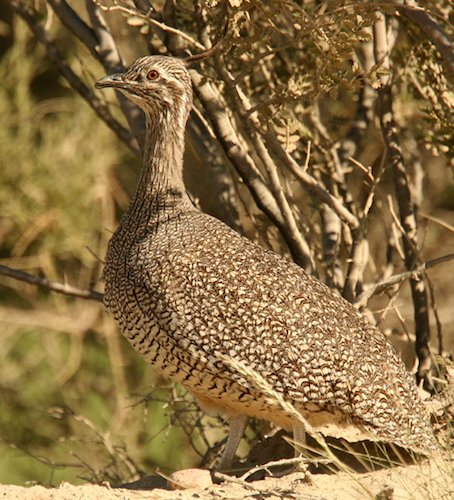
Tinamous form a family; the Tinamidae, the sole family in the Tinamiformes order. There are 46 species of birds in nine genera. They are found in Mexico, Central America, and South America. One of the most ancient living groups of bird, they first appear in the fossil record in the Miocene epoch. Tinamous have traditionally been regarded as the sister group of the flightless ratites, but recent work places them well within the ratite radiation, implying basal ratites could fly.
They are generally sedentary, ground-dwelling birds and, although not flightless, when possible, they avoid flight in favour of hiding or running away from danger. They are found in a variety of habitats, ranging from semi-arid alpine grasslands to tropical rainforests.

Andean Tinamou Nothoprocta pentlandii – ©Dubi Shapiro
Although some species are quite common, tinamous are shy and secretive birds. They are active during the day, retiring to roosts at night. They generally have cryptic plumage, with males and females similar in appearance, although the females are usually larger. They are opportunistic and omnivorous feeders, consuming a wide variety of plant and animal food from fruits and seeds to worms, insects and small vertebrates. They will dust-bathe as well as wash themselves by standing in heavy rain. They are heard more often than seen, communicating with each other by a variety of frequently given, characteristic calls, especially during the breeding season.
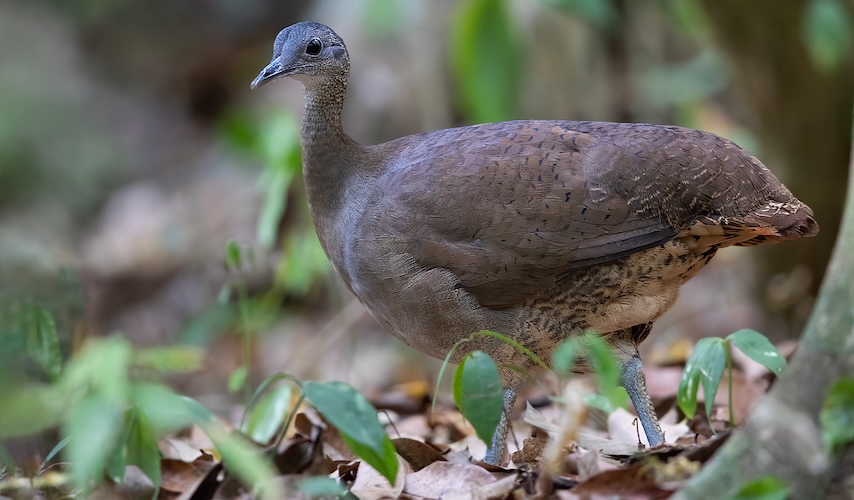
Great Tinamou Tinamus major – ©Dubi Shapiro
With occasional exceptions, a male tinamou maintains a territory and a nesting site during the breeding season, which a succession of females will visit, laying their eggs in the same nest. Females will wander through several territories mating with, and laying eggs in the nests of the resident males. Nests are always on the ground, concealed in vegetation or among rocks. Eggs are relatively large and glossy, often brightly coloured when laid, and are incubated by the males for a period of two to three weeks. The chicks can run soon after hatching and are largely self-sufficient at three weeks old.
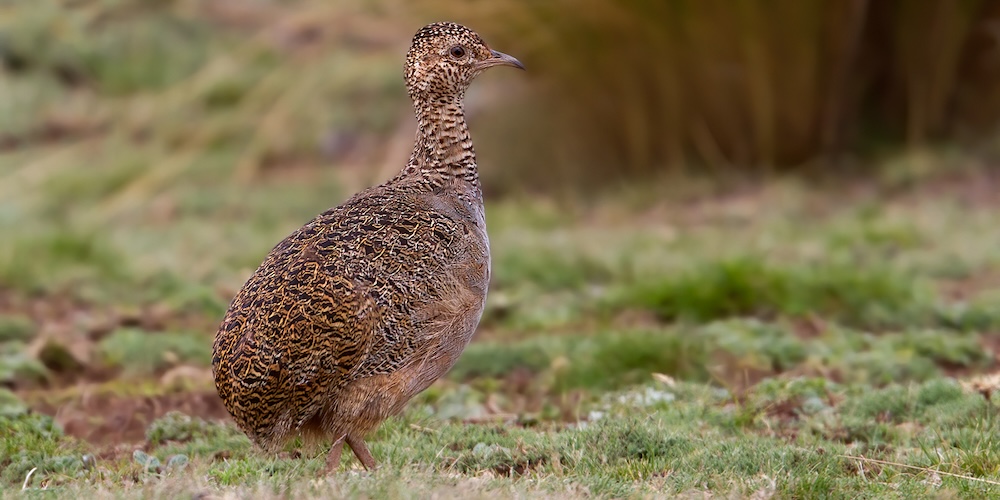
Ornate Tinamou Nothoprocta ornata – ©Dubi Shapiro
Tinamous and their eggs have many natural predators, from falcons and vampire bats to jaguars and giant anteaters. They have also been extensively hunted by humans and sometimes persecuted as agricultural pests. However, the main threat to their populations is from habitat destruction through land clearing and agricultural development. Seven species are listed as vulnerable and another seven as near threatened.
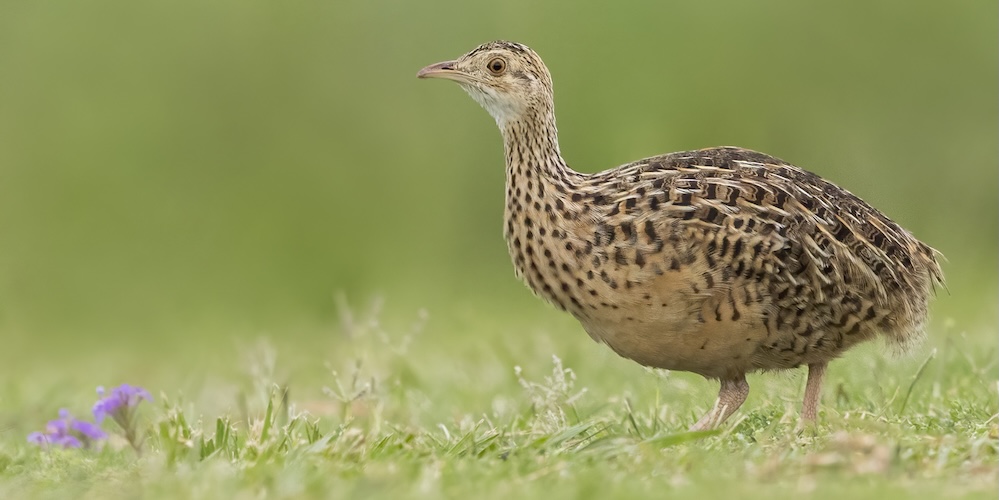
Spotted Nothura Nothura maculosa – ©Dubi Shapiro
They are often translocated and are easily bred in captivity, yet they have never been successfully domesticated. Two groups of species are broadly divided by habitat, with the Nothurinae being steppe or open country tinamous, and the Tinaminae being forest tinamous.
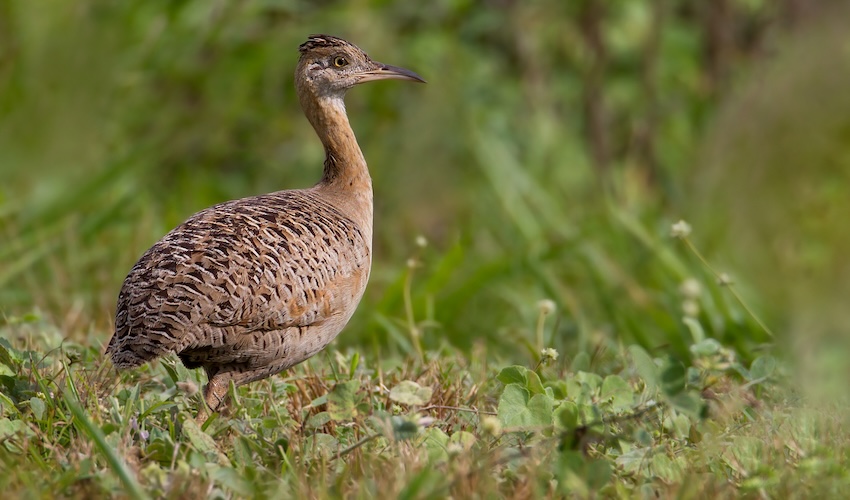
Red-winged Tinamou Rhynchotus rufescens – ©Dubi Shapiro
They feature in the mythology of the indigenous peoples of their range and Panamanian tradition states that after the ‘Great Flood’, the great tinamou grew frightened of the bright colours in the rainbow. He flew away from the rainbow, the ark, and the rest of the animals, heading for the darkest part of the forest, where he has remained ever since.
-
Number of bird species: 46
(As at July 2025)
According to the recently combined AviList, there are 46 species in the Tinamidae family. (The Chaco Nothura is demoted to a subspecies of Spotted Nothura because of a very small variation in plumage, morphometrics, vocalizations and genetics.) They are:
Puna Tinamou Tinamotis pentlandii
Patagonian Tinamou Tinamotis ingoufi
Quebracho Crested Tinamou Eudromia formosa
Elegant Crested Tinamou Eudromia elegans
Dwarf Tinamou Taoniscus nanus
White-bellied Nothura Nothura boraquira
Lesser Nothura Nothura minor
Darwin’s Nothura Nothura darwinii
Spotted Nothura Nothura maculosa
Chaco Nothura Nothura (maculosa) chacoensis
Huayco Tinamou Rhynchotus maculicollis
Red-winged Tinamou Rhynchotus rufescens
Taczanowski’s Tinamou Nothoprocta taczanowskii
Ornate Tinamou Nothoprocta ornata
Chilean Tinamou Nothoprocta perdicaria
Brushland Tinamou Nothoprocta cinerascens
Andean Tinamou Nothoprocta pentlandii
Curve-billed Tinamou Nothoprocta curvirostris
Tawny-breasted Tinamou Nothocercus julius
Highland Tinamou Nothocercus bonapartei
Hooded Tinamou Nothocercus nigrocapillus
Grey Tinamou Tinamus tao
Solitary Tinamou Tinamus solitarius
Black Tinamou Tinamus osgoodi
Great Tinamou Tinamus major
White-throated Tinamou Tinamus guttatus
Cinereous Tinamou Crypturellus cinereus
Berlepsch’s Tinamou Crypturellus berlepschi
Little Tinamou Crypturellus soui
Tepui Tinamou Crypturellus ptaritepui
Brown Tinamou Crypturellus obsoletus
Undulated Tinamou Crypturellus undulates
Pale-browed Tinamou Crypturellus transfasciatus
Brazilian Tinamou Crypturellus strigulosus
Grey-legged Tinamou Crypturellus duidae
Red-legged Tinamou Crypturellus erythropus
Yellow-legged Tinamou Crypturellus noctivagus
Black-capped Tinamou Crypturellus atrocapillus
Slaty-breasted Tinamou Crypturellus boucardi
Choco Tinamou Crypturellus kerriae
Variegated Tinamou Crypturellus variegatus
Thicket Tinamou Crypturellus cinnamomeus
Rusty Tinamou Crypturellus brevirostris
Bartlett’s Tinamou Crypturellus bartletti
Small-billed Tinamou Crypturellus parvirostris
Barred Tinamou Crypturellus casiquiare
Tataupa Tinamou Crypturellus tataupa
-
Ratites and Tinamous
| By Stephen Davies, Mike Bamford & Danika Loomes | Oxford University Press | 2002 | Hardback | 310 pages, 12 colour plates, tables, distribution maps | ISBN: 9780198549963 Buy this book from NHBS.com
-
Tinamidae
Family AccountAnnotated List -
Tinamidae
Family AccountTinamous are members of the order Tinamiformes and family Tinamidae divided into two distinct subfamilies, containing 46 species found in Mexico...
-
Black Tinamou Tinamus osgoodi
Species AccountSound archive and distribution map. -
Black Tinamou Tinamus osgoodi
Species AccountThe black tinamou (Tinamus osgoodi) is a species of ground bird found in humid foothill and montane forest in the Andes of South America. -
Darwin’s Nothura Nothura darwinii
Species AccountQuail-like tinamou found in a variety of open habitats including grassland, farmland, and steppe. -
Darwin’s Nothura Nothura darwinii
Species AccountDarwin's nothura (Nothura darwinii) is a type of tinamou commonly found in high-altitude grassland in the southern Andes in South America. -
Darwin’s Nothura Nothura darwinii
Species AccountSound archive and distribution map. -
Dwarf Tinamou Taoniscus nanus
Species AccountTiny, retiring, plump tinamou with short legs. Rusty brown and variegated above, with a white chin and center to the belly and a barred breast and flanks. -
Dwarf Tinamou Taoniscus nanus
Species AccountThe dwarf tinamou (Taoniscus nanus), also known as the least tinamou, is a small, superficially partridge-like bird with short tail and wings, found only in Brazil. -
Dwarf Tinamou Taoniscus nanus
Species AccountSound archive and distribution map. -
Elegant Crested Tinamou Eudromia elegans
Species AccountSound archive and distribution map. -
Elegant Crested Tinamou Eudromia elegans
Species AccountThe elegant crested tinamou or martineta tinamou (Eudromia elegans) is a medium-sized tinamou that can be found in southern Chile and Argentina[3] in shrubland. -
Elegant Crested Tinamou Eudromia elegans
Species Account -
Great Tinamou Tinamus major
Species Account -
Great Tinamou Tinamus major
Species AccountSound archive and distribution map. -
Grey Tinamou Tinamus tao
ImagesExcellent images -
Grey Tinamou Tinamus tao
Species AccountSound archive and distribution map. -
Highland Tinamou Nothocercus bonapartei
Species Account -
Highland Tinamou Nothocercus bonapartei
Species AccountSound archive and distribution map. -
Hooded Tinamou Nothocercus nigrocapillus
Species AccountSound archive and distribution map. -
Hooded Tinamou Nothocercus nigrocapillus
Species Account -
Hooded Tinamou Nothocercus nigrocapillus
Species AccountIUCN species profile... -
Little Tinamou Crypturellus soui
Species Account -
Little Tinamou Crypturellus soui
Species AccountSound archive and distribution map. -
Ornate Tinamou Nothoprocta ornata
Species AccountGray-and-brown chicken-like bird found at high elevations in rocky Andean scrub and grasslands. Finely barred across its head, back, and wings. -
Ornate Tinamou Nothoprocta ornata
Species AccountThe ornate tinamou (Nothoprocta ornata) is a type of tinamou commonly found in the high altitude grassland and dry shrubland in subtropical and tropical... -
Ornate Tinamou Nothoprocta ornata
Species AccountSound archive and distribution map. -
Patagonian Tinamou Tinamotis ingoufi
Species AccountLarge, cryptically patterned chickenlike bird of Patagonian grasslands with bushes and low shrubs. Scarce and rarely enco -
Patagonian Tinamou Tinamotis ingoufi
Species AccountThe Patagonian tinamou (Tinamotis ingoufi) also known as Ingouf's tinamou is a member of one of the most ancient groups of paleognath birds, the tinamous. -
Patagonian Tinamou Tinamotis ingoufi
Species AccountSound archive and distribution map. -
Red-winged Tinamou Rhynchotus rufescens
Species AccountSound archive and distribution map. -
Red-winged Tinamou Rhynchotus rufescens
Species AccountDistinctive tinamou with a densely barred body, orangish neck, and dark brown crown that can be raised. -
Red-winged Tinamou Rhynchotus rufescens
Species AccountThe red-winged tinamou (Rhynchotus rufescens) is a medium-sized ground-living bird from central and eastern South America. -
Rusty Tinamou Crypturellus brevirostris
Species AccountSmall tinamou, barred cinnamon and black above, rusty below, with a pale belly. Found mostly in seasonally flooded forest, but also recorded in upland forest. -
Rusty Tinamou Crypturellus brevirostris
Species Accounthe rusty tinamou or short-billed tinamou (Crypturellus brevirostris) is a type of tinamou commonly found in swamp forest in tropical regions of South... -
Rusty Tinamou Crypturellus brevirostris
Species AccountSound archive and distribution map. -
Solitary Tinamou Tinamus solitarius
Species AccountSound archive and distribution map. -
Tawny-breasted Tinamou Nothocercus julius
Species Account -
Tawny-breasted Tinamou Nothocercus julius
Species AccountSound archive and distribution map. -
White-throated Tinamou Tinamus guttatus
Species Account -
White-throated Tinamou Tinamus guttatus
Species AccountSound archive and distribution map.
-
Incubation in Great Tinamou Tinamus major
ArticlePatricia L. R. Brennan - The Wilson Journal of Ornithology, Vol. 121, No. 3 (Sep., 2009), pp. 506-511
